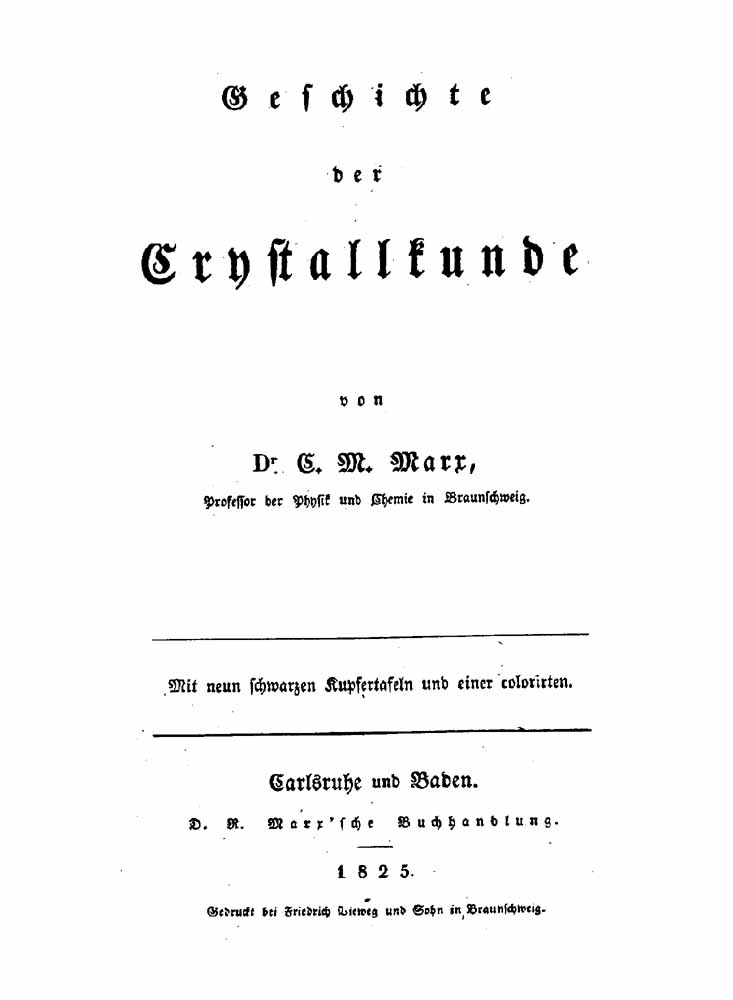MARX, Carl Michael.
(1794 – 1864)
Marx was a docent at the University of Heidelberg in 1814. This was followed by instructing positions at Pestalozzi's Institute in Yverdun (1815-17), the Lyceum in Carlsruhe (1817-19) and the Educational Institute in Nürnberg (1819-23). In 1824, Marx was appointed professor of physics and chemistry at the Collegium Carolinum in Braunsweig, from which he retired in 1847.
Biographical references: DBA: II 860, 166-169. • Lambrecht & Quenstedt, Catalogus, 1938: 283. • Poggendorff: 2, cols. 69-70 & 3, 879. • WBI.

1. German, 1825.
Geschichte | Der | Crystallkunde | von | Dr. C.M. Marx, | Professor der Physik und Chemie in Braunschweig. | [rule] | Mit neun schwarzen Kupfertafeln und einer colorirten. | [rule] | Carlsruhe und Baden. | D.R. Marx'sche Buchhandlung. | [rule] | 1825. | Gedruckt bei Friedrich Bieweg und Sohn in Braunschweig.
8°: π7 1-198 206; 165l.; [i]-xiv, [2], [1]-313, [3] p., 10 plates (one folding and colored). Page size: 185 x 115 mm.
Contents: [i-ii], Title page, verso blank.; [iii], Dedication to Count von Schmidt-Phiseldeck.; [iv], Blank.; [v-xii], Preface-signed Carl Michael Marx, 16 May 1825.; [xiii]-xiv, "Uebersicht des Inhalts."; 1, "Geschichte | der | Crystallkunde."; [2], Quotation from Goethe concerning colors.; [3]-297, Text.; [298]-301, "Rückblick."; [302]-309, "Zusätze."; [310]-313, "Namen-Verzeichniß."; [1 pg], "Berichtigungen."; [1 pg], "Abbildungen."; [1 pg], Blank.; [At end], 10 plates (one folding and hand-colored).
Very rare. A highly respected work that develops an understanding of concepts in what was then modern crystallography through historical perspective. As a result, the book covers the history of crystallography from ancient times to 1824. The development is told by describing the contributions of the individuals in chronological order. The text is divided into six sections, each representing a specific time period. The first covers the ancient Greek and Roman researches. The others span (2) Albertus Magnus to Robert Boyle, (3) Nicolaus Steno to Johann Henckel, (4) Carl Linné to Jean Baptiste Louis Romé de l'Isle, (5) René Just Haüy to Henry James Brooke, and (6) Abraham Gotthelf Kästner to Friedrich Mohs. The name index lists about 300 researches, whose contributions are described in the text. The plates illustrate various concepts brought forth in the discussion by reproducing recognizable figures from important crystallographic works.
Facsimile reprint, 1970: Geschichte | ... | Wiesbaden | Dr. Martin Sändig oHG. 8°: [i]-xiv, [2], [1]-313, [2], [1] blank p., 10 plates (one folding and colored). Photographic reprint of the original edition with a modified title page. ISBN 3500220002.
Bibliographical references: BL [726.c.34.]. • Dana's 7th (Bibliography): 77.
2. German, 1831.
Handbuch der analytische Geometrie, in besonderer Beziehung auf Physik und Krystallographie. Braunschweig, 1831.
8°. Very scarce.
Bibliographical references: BL [no copy listed]. • Poggendorff: 2, 69-70.
.